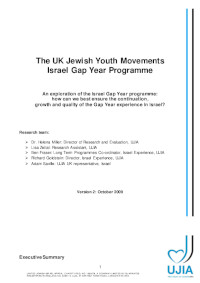The UK Jewish Youth Movements Israel Gap Year Programme. An exploration of the Israel Gap Year programme: how can we best ensure the continuation, growth and quality of the Gap Year experience in Israel?
Author(s)
Publication Date
Publisher
Abstract
Key issues and findings are as follows:
1. 30% of Jewish 18 year olds take a Gap Year after finishing school.
2. 17% of Jewish 18 year olds currently choose an Israel Gap Year.
3. That percentage is decreasing.
4. The cost of the Israel Gap Year has risen from £7,000 - £11,000 in three years.
5. That cost is within proportion of some non-Israel Gap Year programmes. It is higher than others.
6. For many families, the cost of Israel Gap Year is prohibitive. The finances of the Israel Gap Year must be reviewed. This must include issues related to length, structure and content of the year, bursaries, saving schemes, raising funds etc.
7. The variable quality of the Machon and the price of the Machon is making it a challenging component of the programme.
8. The volunteering programme must address the issues stated in the UJIA Review of Volunteering paper (2008)
9. Better marketing will lead to higher recruitment. Marketing of the UJIA Israel Gap Year needs to be as sophisticated as marketing for non-Israel Gap Years
10. Follow through of chanichim after Israel Tour must be better addressed by the Youth Movements in the UK.
11. The possibility of developing shorter options (5-6 months) must be explored seriously.
12. The option of making the programme modular – 3 month modules that participants can pick and choose from and opt in and out of – must be explored.
13. UJIA and the Youth Movements must explore the possibility of better integration between the sections of the Gap Year.
14. UJIA and the Youth Movements should explore the desirability and possibility of including a three month component overseas, possibly volunteering in Europe or in a developing country.
15. The staffing of the Israel Experience team should be reviewed to ensure adequate cover both in the UK and in Israel, particularly at present when staff cuts and turnover of staff is acute.
16. The impact of the Gap Year on its participants is one of its unique selling points and should not be under-estimated. It should be integrated into the marketing strategy.
1. 30% of Jewish 18 year olds take a Gap Year after finishing school.
2. 17% of Jewish 18 year olds currently choose an Israel Gap Year.
3. That percentage is decreasing.
4. The cost of the Israel Gap Year has risen from £7,000 - £11,000 in three years.
5. That cost is within proportion of some non-Israel Gap Year programmes. It is higher than others.
6. For many families, the cost of Israel Gap Year is prohibitive. The finances of the Israel Gap Year must be reviewed. This must include issues related to length, structure and content of the year, bursaries, saving schemes, raising funds etc.
7. The variable quality of the Machon and the price of the Machon is making it a challenging component of the programme.
8. The volunteering programme must address the issues stated in the UJIA Review of Volunteering paper (2008)
9. Better marketing will lead to higher recruitment. Marketing of the UJIA Israel Gap Year needs to be as sophisticated as marketing for non-Israel Gap Years
10. Follow through of chanichim after Israel Tour must be better addressed by the Youth Movements in the UK.
11. The possibility of developing shorter options (5-6 months) must be explored seriously.
12. The option of making the programme modular – 3 month modules that participants can pick and choose from and opt in and out of – must be explored.
13. UJIA and the Youth Movements must explore the possibility of better integration between the sections of the Gap Year.
14. UJIA and the Youth Movements should explore the desirability and possibility of including a three month component overseas, possibly volunteering in Europe or in a developing country.
15. The staffing of the Israel Experience team should be reviewed to ensure adequate cover both in the UK and in Israel, particularly at present when staff cuts and turnover of staff is acute.
16. The impact of the Gap Year on its participants is one of its unique selling points and should not be under-estimated. It should be integrated into the marketing strategy.
Topics
Genre
Geographic Coverage
Copyright Holder
Copyright Info
All rights reserved
Original Language
Related
Bibliographic Information
The UK Jewish Youth Movements Israel Gap Year Programme. An exploration of the Israel Gap Year programme: how can we best ensure the continuation, growth and quality of the Gap Year experience in Israel?. . 2009: https://archive.jpr.org.uk/object-uk307




